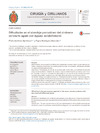Please use this identifier to cite or link to this item:
https://accedacris.ulpgc.es/handle/10553/43654
| DC Field | Value | Language |
|---|---|---|
| dc.contributor.author | Martínez-Quintana, Efrén | en_US |
| dc.contributor.author | Rodríguez-González, Fayna | en_US |
| dc.date.accessioned | 2018-11-21T16:50:38Z | - |
| dc.date.available | 2018-11-21T16:50:38Z | - |
| dc.date.issued | 2016 | en_US |
| dc.identifier.issn | 0009-7411 | en_US |
| dc.identifier.uri | https://accedacris.ulpgc.es/handle/10553/43654 | - |
| dc.description.abstract | Background: Peripheral arterial disease and coronary artery disease are frequently associated. The percutaneous approach may sometimes involve additional difficulties to the coronary artery disease.Clinical case: The case is presented on an 82 year-old male patient with multiple cardiovascular risk factors, a Leriche syndrome and axillobifemoral bypass, who was admitted to hospital due to an inferior myocardial infarction. The procedure approach (radial, brachial, or femoral accessroutes for percutaneous coronary treatment) and associated complications from the procedureare discussed.Conclusion: Although technical improvements and/or treatment of peripheral vascular lesionsmay allow percutaneous coronary intervention, individual risk and benefit in each patient mustbe assessed. (C) 2015 Academia Mexicana de Cirugia A.C. Published by Masson Doyma Mexico S.A. | en_US |
| dc.language | spa | en_US |
| dc.publisher | 0009-7411 | - |
| dc.relation.ispartof | Cirugía y cirujanos | en_US |
| dc.source | Cirugia y Cirujanos[ISSN 0009-7411],v. 84(5), p. 405-408, (Septiembre-Octubre 2016) | en_US |
| dc.subject | 321307 Cirugía del corazón | en_US |
| dc.subject.other | Peripheral Arterial-Disease | en_US |
| dc.subject.other | Direct Puncture | en_US |
| dc.subject.other | Global Registry | en_US |
| dc.subject.other | Outcomes | en_US |
| dc.title | Dificultades en el abordaje percutáneo del síndrome coronario agudo con bypass axilobifemoral | en_US |
| dc.title.alternative | Difficulties in the percutaneous approach of the acute coronary syndrome with associated axillobifemoral bypass | en_US |
| dc.type | info:eu-repo/semantics/Article | en_US |
| dc.type | Article | en_US |
| dc.identifier.doi | 10.1016/j.circir.2015.05.054 | en_US |
| dc.identifier.scopus | 2-s2.0-84992488236 | - |
| dc.identifier.isi | 000388278900009 | - |
| dc.contributor.authorscopusid | 23485891800 | - |
| dc.contributor.authorscopusid | 24825586600 | - |
| dc.description.lastpage | 408 | en_US |
| dc.identifier.issue | 5 | - |
| dc.description.firstpage | 405 | en_US |
| dc.relation.volume | 84 | en_US |
| dc.investigacion | Ciencias de la Salud | en_US |
| dc.type2 | Artículo | en_US |
| dc.contributor.daisngid | 614797 | - |
| dc.contributor.daisngid | 648988 | - |
| dc.utils.revision | Sí | en_US |
| dc.contributor.wosstandard | WOS:Martinez-Quintana, E | - |
| dc.contributor.wosstandard | WOS:Rodriguez-Gonzalez, F | - |
| dc.date.coverdate | Septiembre-Octubre 2016 | en_US |
| dc.identifier.ulpgc | Sí | en_US |
| dc.contributor.buulpgc | BU-MED | en_US |
| dc.description.sjr | 0,164 | |
| dc.description.jcr | 0,276 | |
| dc.description.sjrq | Q3 | |
| dc.description.jcrq | Q4 | |
| dc.description.scie | SCIE | |
| item.fulltext | Con texto completo | - |
| item.grantfulltext | open | - |
| crisitem.author.dept | Departamento de Ciencias Médicas y Quirúrgicas | - |
| crisitem.author.fullName | Martínez Quintana, Efrén | - |
| Appears in Collections: | Artículos | |
Page view(s)
69
checked on Jan 18, 2025
Download(s)
71
checked on Jan 18, 2025
Google ScholarTM
Check
Altmetric
Share
Export metadata
Items in accedaCRIS are protected by copyright, with all rights reserved, unless otherwise indicated.
